State funeral of John F. Kennedy
The state funeral of John F. Kennedy, 35th President of the United States, took place in Washington, D.C., during the three days that followed his assassination on Friday, November 22, 1963, in Dallas, Texas.[1]
| ||
|---|---|---|
President of the United States
Appointments
Assassination and legacy
|
||
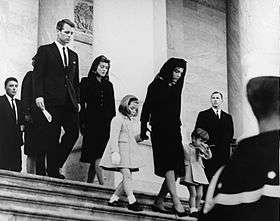
The body of President Kennedy was brought back to Washington soon after his death and was placed in the East Room of the White House for 24 hours.[2] On the Sunday after the assassination, his flag-draped casket was carried on a horse-drawn caisson to the U.S. Capitol to lie in state.[3] Throughout the day and night, hundreds of thousands lined up to view the guarded casket.[4][5]
Representatives from over 90 countries attended the state funeral on Monday, November 25.[6] After the Requiem Mass at St. Matthew's Cathedral, the late president was buried at Arlington National Cemetery in Virginia.[7]
Preparations for the state funeral
After John F. Kennedy was assassinated in Dallas, his body was flown back to Washington,[8] and taken to Bethesda Naval Hospital for the autopsy.[9][10] At the same time, military authorities began making arrangements for a state funeral.[11][12] Army Major General Philip C. Wehle, the commanding general of the Military District of Washington (MDW) (CG MDW), and retired Army Colonel Paul C. Miller, chief of ceremonies and special events at the MDW, planned the funeral.[13][14]
They headed to the White House and worked with the president's brother-in-law, Sargent Shriver, also director of the Peace Corps, and Ralph Dungan, an aide to the president.[13][15][16][17] Because Kennedy had no funeral plan in place, much of the planning rested with the CG MDW.[13] House Speaker John W. McCormack said that the president's body would be brought back to the White House to lie in the East Room the following day and then taken to the Capitol to lie in state in the rotunda all day Sunday.[18]
The day after the assassination, the new president, Lyndon B. Johnson, issued Presidential Proclamation 3561, declaring Monday to be a national day of mourning,[19][20] and only essential emergency workers to be at their posts.[21] He read the proclamation over a nationwide radio and television broadcast at 4:45 p.m. from the Fish Room (currently known as the Roosevelt Room) at the White House.[19][22]
Several elements of the state funeral paid tribute to Kennedy's service in the Navy during World War II. They included a member of the Navy bearing the presidential flag, the playing of the Navy Hymn, "Eternal Father, Strong to Save," and the Naval Academy Glee Club performing at the White House.[24][25]
White House repose
After the autopsy at Bethesda Naval Hospital, Kennedy's body was prepared for burial by embalmers from Gawler's Funeral Home in Washington, who performed the embalming and cosmetic restoration procedures at Bethesda.[26][27] Then, Kennedy's body was put in a new mahogany casket in place of the bronze casket used to transport the body from Dallas.[26][28] The bronze casket had been damaged in transit,[26] and was later disposed of by the Air Force in the Atlantic Ocean so that it would not "fall into the hands of sensation seekers."[29]
President Kennedy's body was returned to the White House at about 4:30 a.m. EST on Saturday, November 23.[30][31] The motorcade bearing the remains was met at the White House gate by a U.S. Marine Corps honor guard, which escorted it to the North Portico.[30] The pallbearers bore the casket to the East Room where, nearly one hundred years earlier, the body of Abraham Lincoln had lain.[30] Kennedy's casket was placed on a catafalque previously used for the funerals of the Unknown Soldiers from the Korean War and World War II at Arlington.[32] Jacqueline Kennedy declared that the casket would be kept closed for the viewing and funeral.[33] The shot to Kennedy's head left a gaping wound,[34] and religious leaders said that a closed casket minimized morbid concentration on the body.[35]
Mrs. Kennedy, still wearing the blood-stained suit she wore in Dallas,[30] had not left the side of her husband's body since he was shot.[36] Only after the casket was placed in the East Room, draped with black crepe,[37] did she retire to her private quarters.[38]
Kennedy's body lay in repose in the East Room for 24 hours,[2] attended by an honor guard including troops from the 3rd Infantry and from the Army's Special Forces (Green Berets).[39][40][41] The Special Forces troops had been brought hurriedly from Fort Bragg in North Carolina, at the request of U.S. Attorney General Robert F. Kennedy, who was aware of his brother's particular interest in them.[40]
Mrs. Kennedy requested two Catholic priests to remain with the body until the official funeral.[42][39] A call was made to The Catholic University of America, and Msgr. Robert Paul Mohan and Fr. Gilbert Hartke, two prominent Washington, D.C., priests, were immediately dispatched for the task.[43] A solemn Mass was celebrated for family in the East Room at 10:30 a.m. on Saturday, November 23.[39] Fr. M. Frank Ruppert of St. Matthew's Cathedral Parish would celebrate a mass in the East Room the following day.[44] After the Mass, other family members, friends, and other government officials came at specified times to pay their respects to President Kennedy.[45][39] This included former U.S. Presidents Harry S. Truman and Dwight D. Eisenhower.[46] The other surviving former U.S. president at the time, Herbert Hoover, was too ill to attend the state funeral,[47] and was represented by his sons, Herbert Hoover Jr. (who also attended the funeral) and Allan Hoover (who went to the services in the US Capitol rotunda).[48][49]
In Lafayette Park, across the street from the White House, crowds stood in the rain, keeping a vigil and paying quiet respects.[50] It rained all day in Washington, befitting the mood of the nation.[51][52][53]
Lying in state

On Sunday afternoon about 300,000 people watched a horse-drawn caisson, which had borne the body of Franklin D. Roosevelt and the Unknown Soldier,[54][44] carry Kennedy's flag-covered casket down the White House drive, past parallel rows of soldiers bearing the flags of the 50 states of the Union,[55] then along Pennsylvania Avenue to the Capitol Rotunda to lie in state.[56] The only sounds on Pennsylvania Avenue as the cortège made its way to the Capitol were the sounds of the muffled drums and the clacking of horses' hooves, including the riderless (caparisoned) horse Black Jack.[54][57]
The widow, holding her two children by the hand, led the public mourning for the country.[5][58] In the rotunda, Mrs. Kennedy and her daughter Caroline knelt beside the casket, which rested on the Lincoln catafalque.[59][5][60] Three-year-old John Jr. was briefly taken out of the rotunda so as not to disrupt the service.[59][61] Mrs. Kennedy maintained her composure as her husband was taken to the Capitol to lie in state, as well as during the memorial service.[62]
Brief eulogies were delivered inside the rotunda by Senate Majority Leader Mike Mansfield of Montana, Chief Justice Earl Warren, and Speaker McCormack.[63][64][65]
Kennedy was the first president in more than 30 years to lie in state in the rotunda, the last being William Howard Taft in 1930,[66] and the first Democrat to lie in state at the Capitol.[67] In fact, he was one of only two Democratic presidents to lie in state at the Capitol; the other being LBJ, in 1973.[67]
Public viewing
In the only public viewing, thousands lined up in near-freezing temperatures to view the casket.[4] Over the span of 18 hours, 250,000 people,[68][69][5][70] some waiting for as long as 10 hours in a line up to 10 persons wide that stretched 40 blocks,[71] personally paid their respects as Kennedy's body lay in state. United States Capitol Police officers politely reminded mourners to keep moving along in two lines that passed on either side of the casket and exited the building on the west side facing the National Mall.[54][71]
The original plan was for the rotunda to close at 9:00 p.m. and reopen for an hour at 9:00 the next morning.[72][73] Because of long lines police and military authorities decided to keep the doors open.[71] At 9:00 p.m., when the rotunda was supposed to close, both Jacqueline Kennedy and Robert F. Kennedy returned to the rotunda again.[74] More than half the mourners came to the rotunda after 2:45 a.m., by which time 115,000 had already visited.[54][73] Military officials doubled the lines, first to two abreast, then to four abreast.[71]
NBC broadcast uninterrupted coverage of the people passing through the Capitol rotunda during the overnight hours.[75][76][71][77] Reuven Frank recounted that NBC News vice-president Bill McAndrew ordered pictures of the crowds passing through the rotunda all night, which provided a calming effect.[77] While anchoring the Today show from an NBC Washington studio the next day, Hugh Downs said that the numbers made it "the greatest and most solemn wake in history."[78] CBS Washington correspondent Roger Mudd said of the numbers: "This outpouring of affection and sympathy for the late president is probably the most majestic and stately ceremony the American people can perform."[79] Jersey Joe Walcott, a former heavyweight boxing champion, passed by the bier at 2:30 a.m.[72][80] and agreed with Mudd, saying of Kennedy, "He was a great man."[81]
Arrival of dignitaries
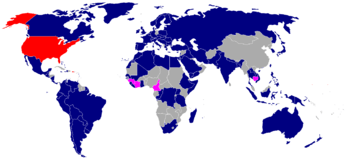
As Kennedy lay in state, foreign dignitaries—including heads of state and government and members of royal families—started to arrive in Washington to attend the state funeral on Monday.[82][83][84] Secretary of State Dean Rusk and other State Department personnel went to both of Washington's commercial airports to personally greet foreign dignitaries.[85][84][86]
Some of the dignitaries that arrived on Sunday to attend the funeral included Soviet First Deputy Premier Anastas Mikoyan,[87] French President Charles de Gaulle, Canadian Prime Minister Lester B. Pearson, the Duke of Edinburgh (representing Queen Elizabeth II), British Prime Minister Sir Alec Douglas-Home, Irish President Éamon de Valera, and Ethiopian Emperor Haile Selassie.[77]
Queen Frederica of the Hellenes, and King Baudouin I of the Belgians were just some of the other members of royalty attending. Some law enforcement officials, including MPDC Chief Robert V. Murray, later said that it was the biggest security nightmare they ever faced.[82][88]
Funeral
As people were viewing the casket, military authorities held meetings at the White House, at MDW headquarters, and at Arlington National Cemetery to plan Monday's events.[89] First, they decided that the public viewing should end at 9:00 a.m. EST[73] and that the ceremonies would begin at 10:30 a.m. EST.[90]
Unlike Sunday's procession, which was led by only the muffled drum corps,[91] Monday's was expanded to include other military units.[92][93][94] Military officials also agreed to requests from Kennedy's widow, Jacqueline Kennedy.[89] They agreed that the Marine Band should lead the funeral procession,[89][95] which would include two foreign military units—10 pipers from the Scottish Black Watch (Royal Highland Regiment) marching from the White House to St. Matthew's Roman Catholic Cathedral,[96] a group of 30 Irish Defence Forces cadets—at the request of Mrs. Kennedy—performing silent drill at the grave site, and placement of an eternal flame at the grave.[97][98] The cadets came from the Curragh Camp, County Kildare, Republic of Ireland.[92] The cadets traveled with Irish President Éamon de Valera, and together they paid tribute to Kennedy's Irish ancestry.[92]
Approximately one million people lined the route of the funeral procession, from the Capitol back to the White House, then to St. Matthew's Cathedral, and finally to Arlington National Cemetery.[99][5] Millions more followed the funeral on television.[100][101] Those who watched the funeral on television were the only ones who saw the ceremony in its entirety.[102] The three networks, ABC, CBS, and NBC, used at least 50 cameras for the joint coverage in order to allow viewers to follow the proceedings in their entirety from the Capitol to Arlington.[103] In addition, the networks' Washington bureau chiefs (Bob Fleming at ABC, Bill Monroe at NBC, and Bill Small at CBS) moved correspondents and cameras to keep them ahead of the cortège.[103][104]
The day's events began at 8:25 a.m., when the MPDC cut off the line of mourners waiting to get into the rotunda.[105] They did so because a large group tried to break into the line and the MPDC were not able to sort out those who had already been in line, many of whom had waited for five hours.[71][70] Thirty-five minutes, later, the doors closed, ending the lying in state;[71] the last visitors passed through at 9:05 a.m.[105]
At 10:00 a.m., both houses of Congress met to pass resolutions expressing sorrow.[68][106] In the Senate, Maine Republican Senator Margaret Chase Smith laid a single rose on the desk Kennedy had occupied when in the Senate.[107]
Procession to cathedral

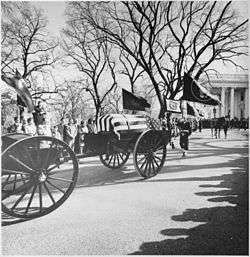
After Jacqueline Kennedy and her brothers-in-laws, Attorney General Robert Kennedy and Massachusetts Democratic Senator Ted Kennedy, visited the rotunda, the coffin was carried out onto the caisson.[90] At 10:50, the caisson left the Capitol.[108] Ten minutes later, the procession began,[105] making its way back to the White House. As the procession reached the White House, all the military units except for the Marine company turned right off Pennsylvania Avenue and onto 17th Street.[109] A platoon of the Marine company turned in the northeast gate and led the cortege into the North Portico.[109]
At the White House, the procession resumed on foot for roughly 0.9 miles (1.4 km) to St. Matthew's Cathedral, led by Jacqueline Kennedy and the late president's brothers, Robert and Edward (Ted) Kennedy.[110] They walked the same route that John F. Kennedy and Jacqueline Kennedy often used when going to Mass at the cathedral.[44][110] This also marked the first time that a first lady walked in her husband's funeral procession.[111] The two Kennedy children rode in a limousine behind their mother and uncles.[112] The rest of the Kennedy family, apart from the president's father, Joseph P. Kennedy Sr., who was ill,[113] waited at the cathedral.[114]
The new president Lyndon B. Johnson, his wife Lady Bird, and their two daughters Luci and Lynda also marched in the procession.[102] Johnson had been advised not to do so because of the potential risk in the wake of Kennedy's assassination.[115] Johnson recounted his experiences in his memoirs, saying, "I remember marching behind the caisson to St. Matthew's Cathedral. The muffled rumble of drums set up a heartbreaking echo."[116] He told Merle Miller: "Walking in the procession was one of the most difficult decisions I made. The FBI...and the Secret Service felt...it would be injudicious and unwise for the American president to expose himself by walking along the avenue with all the buildings on each side...I...concluded...that it was something I wanted to do, should do, and would do, and did so."[115] When he moved into the oval office the next day, there was a letter from Mrs. Kennedy on his desk, which began "Thank you for walking yesterday..."[115]
Not since the funeral of Britain's King Edward VII, in 1910, had there been such a large gathering of presidents, prime ministers, and royalty at a state funeral.[117][118] In all, 220 foreign dignitaries from 92 countries, five international agencies, and the papacy attended the funeral.[119][6][120] The dignitaries including 19 heads of state and government and members of royal families.[117] Most of the dignitaries passed unnoticed, following respectfully behind the former first lady and the Kennedy family during the relatively short walk to the cathedral along Connecticut Avenue.[6][121] It was also one of the greatest turnout of heads of state and government in American history.[122] NBC Producer Reuven Frank recounted in his autobiography that everybody in the NBC Control room gasped when seeing the heads of state marching on foot, as many of them had just read Barbara Tuchman's Guns of August, which opened with the funeral of the British king.[77]
As the dignitaries marched, there was a heavy security presence because of concerns for the potential assassination of so many world leaders,[123][124] the greatest being for French President Charles de Gaulle, who had specific threats against his life.[125][85] Under Secretary of State George Ball manned the operations center at the State Department with the goal of ensuring that no incident occurred.[86] He recounted in his memoirs, The Past Has Another Pattern, that he "felt that it was imperative that a responsible official remain at the center of communications, ready to deal with such an emergency."[86] He manned the operations center with his deputy for political affairs, U. Alexis Johnson.[86] Rusk recounted that the biggest relief came when de Gaulle himself returned to Paris.[85]
NBC transmitted coverage of the procession from the White House to the cathedral by satellite to twenty-three countries, including Japan and the Soviet Union,[103] allowing hundreds of millions on both sides of the Iron Curtain in Europe to watch the funeral.[126][127] Satellite coverage ended when the coffin went into the cathedral.[128] In the Soviet Union, their commentators said that "the grief of the Soviet people mingles with the grief of the American people."[128] There was no coverage in East Germany, where television audiences had only a soccer match to watch.[128] In Ireland, coverage of the funeral was broadcast live by the television service, Teilifís Éireann to the Irish audience via Telstar satellite. The Irish audience were only able to see the 25 minutes that showed President Kennedy's coffin being brought to St. Matthew's Cathedral. The Irish television audiences also did not see all of the footage live but Michael O'Hehir's audio commentary remained available to them throughout. In Britain, coverage of the funeral was broadcast by both the BBC and ITV who also screened the funeral live via Telstar.[129][130] The BBC's leading news commentator, Richard Dimbleby, gave live commentary of the funeral on BBC-TV,[131] while ITN journalist and broadcaster, Alastair Burnet gave live commentary of the funeral on ITV.
The widow, wearing a black veil, led the way up the steps of the cathedral holding the hands of her two children,[132] with John Jr., whose third birthday fell on the day of his father's funeral,[133] on her left, and Caroline on her right.[117] Because of the funeral and the day of mourning, the widow postponed John Jr.'s birthday party until December 5, the last day the family was in the White House.[134]
Funeral Mass at cathedral
About 1,200 invited guests attended the funeral Mass in the cathedral.[135] The Archbishop of Boston, Richard Cardinal Cushing, celebrated the funeral Mass at the cathedral where Kennedy, a practicing Catholic, often worshipped.[44][136][132] Cardinal Cushing was a close friend of the family who had witnessed and blessed the marriage of Senator Kennedy and Jacqueline Bouvier in 1953.[137] He had also baptized two of their children, given the invocation at President Kennedy's inauguration, and officiated at the recent funeral of their infant son, Patrick Bouvier Kennedy.[137]
At the request of the First Lady, the Requiem Mass was a Pontifical Requiem Low Mass[135]—that is, a simplified version of the Mass, with the Mass recited or spoken and not sung.[135] Two months later, Cardinal Cushing offered a pontifical Solemn High Requiem Mass at Holy Cross Cathedral in Boston, with the city's orchestra and choir singing Mozart's Requiem setting.[138]
There was no formal eulogy at the funeral Mass (the first presidential funeral to feature a formal eulogy was that LBJ.[67]).[139][140] However, the Roman Catholic Auxiliary Bishop of Washington, the Most Reverend Philip M. Hannan, decided to read selections from Kennedy's writings and speeches.[136] Bishop Hannan had been asked to speak by Mrs. Kennedy. The readings included a passage from the third chapter of Ecclesiastes: "There is an appointed time for everything...a time to be born and a time to die...a time to love and a time to hate...a time of war and a time of peace."[141][139] He then concluded his remarks by reading Kennedy's entire Inaugural Address.[141][140][139]
Jacqueline Kennedy requested that Luigi Vena sing Franz Schubert's Ave Maria as he did during the marriage.[137][6] For a few moments, she lost her composure and sobbed as this music filled the cathedral.[6]
Father Leonard Hurley, a Catholic priest, provided the commentary for the funeral mass for the networks.[142][143]
Burial
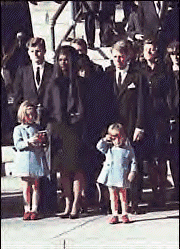
The casket was borne again by caisson on the final leg to Arlington National Cemetery for burial.[144] Moments after the casket was carried down the front steps of the cathedral, Jacqueline Kennedy whispered to her son, after which he saluted his father's coffin;[136][112][145] the image, taken by photographer Stan Stearns,[146] became an iconic representation of the 1960s. NBC News vice-president Julian Goodman called the shot "the most impressive...shot in the history of television"; it was set up by NBC Director Charles Jones who was working for the pool.[147]
The children were deemed to be too young to attend the final burial service, so this was the point where the children said goodbye to their father.[148]
Virtually everyone else followed the caisson in a long line of black limousines passing by the Lincoln Memorial and crossing the Potomac River. Many of the military units did not participate in the burial service and left just after crossing the Potomac.[149] Because the line of cars taking the foreign dignitaries was long, the last cars carrying the dignitaries left St. Matthew's as the procession entered the cemetery.[144][150] The burial services had already begun when the last car arrived.[6] Security guards walked beside the cars carrying the dignitaries,[151] with the one carrying the French president having the most—10.[125][152]
A detachment of 30 cadets from the Irish Defense Forces, performed, at the request of Jackie Kennedy, a silent solemn graveside drill known as the Queen Anne Drill.[97][98] This is the first, and only, time that a foreign army has been invited to deliver honors at the graveside of a US President.[153][154]
The burial services ended at 3:15 p.m. EST,[105] when the widow lit an eternal flame to burn continuously over his grave.[155] At 3:34 p.m. EST,[144] the casket containing his remains was lowered into the earth,[155] as "Kennedy slipped out of mortal sight—out of sight but not out of heart and mind."[144] Kennedy thus became only the second president to be buried at Arlington,[156] after Taft,[156] which meant that, at that time, the two most recent presidents to lie in state in the Capitol rotunda were buried at Arlington.[66] Kennedy was buried at Arlington exactly two weeks to the day he last visited there, when he came for Veterans Day observances.[157][158]
Gallery
 The remains of John F. Kennedy lying in repose in the East Room of the White House on November 23, 1963.
The remains of John F. Kennedy lying in repose in the East Room of the White House on November 23, 1963. Body bearers carrying the casket of President Kennedy up the center steps of the United States Capitol Building, followed by a color guard holding the flag of the President of the United States, and the late President's widow, Jacqueline Kennedy and her children, Caroline Kennedy and John F. Kennedy, Jr., on November 24, 1963.
Body bearers carrying the casket of President Kennedy up the center steps of the United States Capitol Building, followed by a color guard holding the flag of the President of the United States, and the late President's widow, Jacqueline Kennedy and her children, Caroline Kennedy and John F. Kennedy, Jr., on November 24, 1963..jpg) The remains of President Kennedy lying in state in the United States Capitol Rotunda on November 24, 1963.
The remains of President Kennedy lying in state in the United States Capitol Rotunda on November 24, 1963. Jacqueline Kennedy and Robert F. Kennedy about to enter a limousine on November 24, 1963.
Jacqueline Kennedy and Robert F. Kennedy about to enter a limousine on November 24, 1963.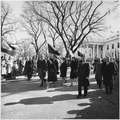 President Lyndon B. Johnson, Lady Bird Johnson, and the Johnson family walking from the White House as part of the funeral procession accompanying President Kennedy's casket to Cathedral of St. Matthew the Apostle on November 25, 1963.
President Lyndon B. Johnson, Lady Bird Johnson, and the Johnson family walking from the White House as part of the funeral procession accompanying President Kennedy's casket to Cathedral of St. Matthew the Apostle on November 25, 1963.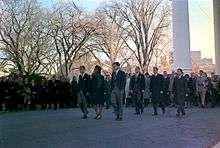 Jacqueline Kennedy, accompanied by her brothers-in-law, Attorney General Robert F. Kennedy and Senator Edward Kennedy, walking from the White House as part of the funeral procession accompanying President Kennedy's casket to Cathedral of St. Matthew the Apostle in Washington D.C. on November 25, 1963.
Jacqueline Kennedy, accompanied by her brothers-in-law, Attorney General Robert F. Kennedy and Senator Edward Kennedy, walking from the White House as part of the funeral procession accompanying President Kennedy's casket to Cathedral of St. Matthew the Apostle in Washington D.C. on November 25, 1963.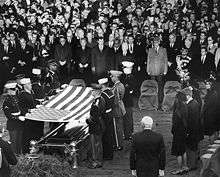 An honor guard folds the flag of the United States at Arlington National Cemetery in preparation for flag presentation to Jacqueline Kennedy on November 25, 1963.
An honor guard folds the flag of the United States at Arlington National Cemetery in preparation for flag presentation to Jacqueline Kennedy on November 25, 1963. Jacqueline Kennedy and Attorney General Robert F. Kennedy walk away from President Kennedy's casket during interment at Arlington National Cemetery on November 25, 1963.
Jacqueline Kennedy and Attorney General Robert F. Kennedy walk away from President Kennedy's casket during interment at Arlington National Cemetery on November 25, 1963.
In popular culture
- The 2016 film, Jackie portrays Jacqueline Kennedy, played by Natalie Portman, as she plans and designs the state funeral.
See also
- Keith Clark, U.S. Army bugler who played "Taps" at Kennedy's funeral
- Foreign military units at the state funeral of John Kennedy
- State funerals in the United States
References
Inline citations
- United Press International & American Heritage Magazine 1964, pp. 3–5
- Associated Press 1963, pp. 36–37, 56–57, 68
- Associated Press 1963, p. 79
- NBC News 1966, pp. 106-107, 110, 114-115, 119-123, 133-134
- White 1965, p. 16
- Wicker, Tom (November 26, 1963). "Kennedy Laid to Rest in Arlington". The New York Times. p. 1.
- United Press International & American Heritage Magazine 1964, pp. 120–127
- Associated Press 1963, pp. 29–30
- Associated Press 1963, pp. 30–31
- NBC News 1966, p. 29-30, 34, 38
- NBC News 1966, pp. 22, 26
- White 1965, p. 9
- Mossman & Stark 1971, p. 188
- Chapman, William (November 27, 1963). "Tense Hours of Planning Assured Kennedy Rites' Flawless Precision". The Washington Post. p. A5.
- "Shriver Decided Funeral Details". The New York Times. November 26, 1963. p. 8.
- Associated Press 1963, pp. 31, 33
- NBC News 1966, pp. 29, 30
- NBC News 1966, pp. 28, 34, 38
- Associated Press 1963, p. 40
- United Press International & American Heritage Magazine 1964, pp. 52–53
- "Government Offices Closed by President". The Washington Post. November 24, 1963. p. A15.
- NBC News 1966, pp. 72–73
- Lowens, Irving (December 1, 1963). "Accurate Listing of Funeral music". The Washington Star. jfklibrary.org. Retrieved August 22, 2011.
- Mossman & Stark 1971, p. 202, 206
- Associated Press 1963, p. 31
- Mossman & Stark 1971, p. 190
- Kinney, Doris G.; Smith, Marcia; Moser, Penny Ward (November 1983). "4 days that stopped America; the Kennedy assassination, 20 years later". Life. 6 (24): 48.
- "JFK's Coffin Dumped At Sea". CBS News. CBSNews.com. June 1, 1999.
- Associated Press 1963, p. 36
- United Press International & American Heritage Magazine 1964, p. 41
- Mossman & Stark 1971, p. 189
- NBC News 1966, pp. 58-59, 83
- Associated Press (November 28, 1963). "Closed Coffin Explained by White House". The Washington Post. p. B8.
- United Press International (November 27, 1963). "Mrs. Kennedy's Opposition To Open Coffin Explained". The New York Times. p. 18.
- Associated Press 1963, pp. 13-15, 22-23, 29-31, 36
- United Press International & American Heritage Magazine 1964, p. 45
- Hamblin, Dora Jane (December 6, 1963). "Mrs. Kennedy's Decisions Shaped all the Solemn Pageantry". Life. 55 (23): 48–49.
- White 1965, p. 14
- Mossman & Stark 1971, pp. 190–191
- Associated Press 1963, p. 68
- NBC News 1966, p. 59
- Santo Pietro, Mary Jo (2002). Father Hartke: His Life and Legacy to the American Theater. Washington D.C.: Catholic University of America Press.
- Associated Press 1963, p. 71
- Mossman & Stark 1971, p. 191
- NBC News 1966, pp. 64, 69-70
- Spivak, Alvin (November 23, 1963). "Kennedy body lies in repose in East Room". United Press International.
Former president Herbert Hoover, who has been ill in recent months, will not be able to attend.
- "Hoover Jr. Will Represent Father at Funeral Service". The New York Times. November 24, 1963. p. 11.
- United Press International (November 24, 1963). "Hoover's Sons to Pay Honors for Father". The Chicago Tribune. p. 11.
- Associated Press 1963, pp. 57
- White 1965, pp. 12, 14
- NBC News 1966, pp. 62, 64, 68
- Associated Press 1963, pp. 40, 56-57
- Wicker, Tom (November 25, 1963). "Grieving Throngs View Kennedy Bier". The New York Times. p. 1.
- United Press International & American Heritage magazine, pp. 72-73
- NBC News 1966, p. 100, 102
- White 1965, pp. 15-16
- Hunter, Marjorie (November 25, 1963). "Mrs. Kennedy Leads Public Mourning". The New York Times. p. 1.
- Associated Press 1963, p. 81
- NBC News 1966, pp. 104-105
- NBC News 1966, pp. 129, 136
- United Press International & American Heritage magazine 1964, p. 84
- NBC News 1966, pp. 102, 105
- United Press International & American Heritage magazine 1964, p. 81, 130
- Associated Press 1963, p. 79, 81
- United Press International (November 26, 1963). "Kennedy is 6th President to Lie in Capitol Rotunda". The New York Times. p. 7.
- Johnson, Haynes; Witcover, Jules (January 26, 1973). "LBJ Buried in Beloved Texas Hills". The Washington Post. p. A1.
- NBC News 1966, p. 133
- United Press International & American Heritage magazine, pp. 94, 97, 99
- Jackman, Frank (November 25, 1963). "Quarter of a million people file past Kennedy bier". United Press International.
- Franklin, Ben A. (November 26, 1963). "250,000 Mourners File Silently Past Coffin in Capitol's Rotunda During 18 Hours". The New York Times. p. 10.
- Associated Press 1963, p. 91
- Associated Press (November 25, 1963). "Thousands Pass Bier at Night Despite the Cold and Long Wait". The New York Times. p. 2.
- United Press International & American Heritage magazine 1964, p. 97
- NBC News 1966, pp. 122–123
- Adams, Val (November 26, 1963). "Back to Normal for Radio and TV". The New York Times. p. 75.
NBC...for five hours yesterday morning (2 to 7 a.m.)...televised only one scene. It came from a stationary camera focused on the thousands filing past the bier of President Kennedy in the Capitol rotunda.
- Frank, Reuven (1991). Out of Thin Air: The Brief Wonderful Life of Network News. New York: Simon & Schuster. p. 190. ISBN 0-671-67758-6.
- NBC News 1966, p. 131
- Mudd 2008, p. 132
- NBC News 1966, p. 123
- Cornell, Douglas B. (November 26, 1963). "Kennedy Laid to Final Rest". Pittsburgh Post-Gazette. Associated Press. p. 1.
- Duscha, Julius (November 25, 1963). "Kings, Presidents and Premiers Here". The Washington Post. p. A1.
- Frankel, Max (November 25, 1963). "Officials of Nearly 100 Lands in U.S.—They Will Meet Johnson". The New York Times. p. 1.
- NBC News 1966, pp. 107, 109-110, 114-115, 120
- Rusk, Dean (1990). Rusk, Richard; Papp, Daniel S. (eds.). As I Saw It. New York: W. W. Norton & Company. p. 321. ISBN 0-393-02650-7.
- Ball, George (1982). The Past Has Another Pattern. New York: W.W. Norton Company. pp. 314-315.
- Tanner, Henry (November 25, 1963). "Mikoyan Flies to Washington As Russians Praise Kennedy". The New York Times. p. 7.
- Franklin, Ben A. (November 25, 1963). "Dignitaries Pose Big Security Risk". New York Times. p. 7.
- Mossman & Stark 1971, p. 198
- Mossman & Stark 1971, p. 205
- Pakenham, Michael (November 25, 1963). "President's Body Lies in the Capitol". The Chicago Tribune. p. 1.
- Raymond, Jack (November 26, 1963). "Riderless Horse an Ancient Tradition". The New York Times. p. 10.
- Mossman & Stark 1971, pp. 200, 203
- United Press International & American Heritage Magazine 1964, p. 139
- NBC News 1966, p. 136
- Mossman & Stark 1971, p. 201, 206-207
- Mossman & Stark 1971, pp. 201-202, 205, 210-211, 215
- NBC News 1966, pp. 83, 139, 149
- United Press International & American Heritage Magazine 1964, p. 99
- Gould, Jack (November 26, 1963). "TV: A Chapter of Honor". The New York Times. p. 11.
In every way but physical presence, untold millions of persons joined in yesterday's final rites for President Kennedy.
- White 1965, pp. 13, 16-17
- White 1965, pp. 16–17
- Shepard, Richard F. (November 26, 1963). "Television Pools Camera Coverage". The New York Times. p. 11.
- Mudd 2008, p. 130
- "Timetable of the Kennedy Funeral and Procession". New York Times. November 26, 1963. p. 4.
- United Press International & American Heritage Magazine 1964, p. 131
- Warden, Philip (November 26, 1963). "Red Rose Marks Kennedy's Senate Desk". The Chicago Tribune. p. A6.
- United Press International & American Heritage Magazine 1964, p. 100
- Mossman & Stark 1971, p. 206
- NBC News 1966, p. 139
- NBC News 1966, pp. 126, 139
- United Press International & American Heritage Magazine 1964, p. 114
- NBC News 1966, pp. 73, 86, 108
- NBC News 1966, pp. 139–140
- Miller, Merle (1980). Lyndon: An Oral Biography. New York: Putnam. pp. 333-336.
- Johnson, Lyndon (1971). The Vantage Point: Perspectives of the Presidency, 1963-1969. New York: Holt, Rinehart, and Winston.
- NBC News 1966, pp. 140
- Duscha, Julius (November 26, 1963). "Mighty World Rulers Pay Humble Tribute". The Washington Post. p. A1.
- Associated Press 1963, p. 93
- United Press International & American Heritage Magazine 1964, pp. 140–141
- NBC News 1966, pp. 139-140
- NBC News 1966, pp. 87, 157
- Lewis, Alfred E. (November 26, 1963). "Net of Security Blankets Washington". The Washington Post. p. A12.
- Associated Press (November 26, 1963). "Maximum Security At Funeral". The Boston Globe. p. 20.
- "Security for de Gaulle Is Tightest in Big Four". The Washington Post. November 26, 1963. p. C13.
- United Press International (November 26, 1963). "Satellite Puts Rites On All-Europe TV". The Boston Globe. p. 26.
- NBC News 1966, p. 157
- Reuters (November 26, 1963). "Telstar Carries Rites". The Chicago Tribune. p. 10.
- Reuters (November 25, 1963). "Britons to See Funeral on TV". The New York Times. p. 4.
- Fellows, Lawrence (November 26, 1963). "Parliament Pays Unusual Tribute". The New York Times. p. 12.
- "A British Program Honoring Kennedy Shown Over NBC". The New York Times. November 25, 1963. p. 10.
- White 1965, p. 17
- NBC News 1966, pp. 126, 142, 152
- United Press International (December 6, 1963). "Mrs. Kennedy Gives Son A Delayed Birthday Party". The New York Times. p. 18.
- NBC News 1966, p. 126
- NBC News 1966, p. 142
- Associated Press 1963, p. 94
- Fenton, John H. (January 20, 1964). "Boston Symphony Plays for Requiem Honoring Kennedy". The New York Times. p. 1.
- Associated Press 1963, pp. 94, 96
- Spivak, Alvin (November 26, 1963). "Eternal flame burns at Kennedy gravesite". United Press International.
At the mass, the Most Reverend Philip Hannan, auxiliary bishop of Washington, read from the fallen president's inaugural address and from his favorite biblical passages. This was the closest approach to a eulogy in the funeral service.
- United Press International & American Heritage Magazine 1964, p. 142
- "Transcript of Commentary at Requiem Mass for Kennedy in Washington". The New York Times. November 26, 1963. p. 4.
- Zimmerman, Mark (November 21, 2013). "Priest Recalls Media Narration of JFK's Funeral". Northwest Catholic. Retrieved December 7, 2019.
- Associated Press 1963, p. 96
- United Press International (November 26, 1963). "John Jr., On 3rd Birthday Salutes His Father's Passing Coffin". The New York Times. p. 5.
- Flegenheimer, Matt (March 5, 2012). "Stan Stearns, 76; Captured a Famous Salute". The New York Times. p. B10.
- NBC Executive Julian Goodman on NBC's coverage of President Kennedy's funeral-EMMYTVLEGENDS on YouTube
- Lewis, Anthony (November 26, 1963). "Mrs. Kennedy Maintains a Stoic Dignity Throughout Final Hours of Public Grief" (PDF). The New York Times. p. 5.
- Mossman & Stark 1971, p. 210
- United Press International (November 26, 1963). "Funeral Traffic Delays Leaders". New York Times. p. 8.
- Baker, Russell (November 26, 1963). "Silence Is Everywhere as Thronged Capital Bids Farewell to President Kennedy". The New York Times. p. 4.
- Frankel, Max (November 26, 1963). "Johnson Meets With Visitors". The New York Times. p. 1.
- Fitzpatrick, Richard (22 November 2013). "The Irish cadets who performed at JFK's graveside". Irish Examiner. Retrieved 6 April 2018.
- Carswell, Simon (November 25, 1963). "Former Irish cadets return to Kennedy graveside". Irish Times. Retrieved 6 April 2018.
- White 1965, p. 18
- NBC News 1966, p. 86, 149
- NBC News 1966, p. 149
- Associated Press (November 26, 1963). "Kennedy Visited Arlington Nov. 11". New York Times. p. 10.
Bibliography
- Associated Press (1963). The Torch is Passed. New York: Associated Press.
- Mossman, B.C.; Stark, M.W. (1971). The Last Salute: Civil and Military Funerals, 1921-1969. Washington: U.S. Government Printing Office.
- Mudd, Roger (2008). The Place to Be: Washington, CBS, and the Glory Days of Television News. New York: PublicAffairs.
- NBC News (1966). There Was a President. New York: Random House.
- United Press International; American Heritage (1964). Four Days. New York: American Heritage Pub. Co.
- White, Theodore Harold (1965). The Making of the President, 1964. New York: Atheneum.
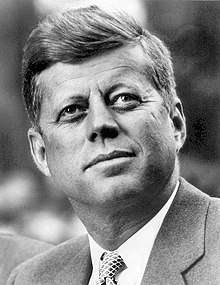


.jpg)